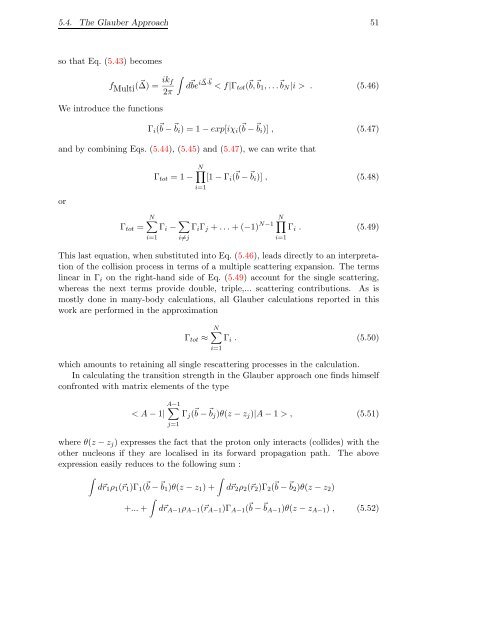Download Thesis in Pdf Format - Theoretical Nuclear Physics and ...
Download Thesis in Pdf Format - Theoretical Nuclear Physics and ...
Download Thesis in Pdf Format - Theoretical Nuclear Physics and ...
You also want an ePaper? Increase the reach of your titles
YUMPU automatically turns print PDFs into web optimized ePapers that Google loves.
5.4. The Glauber Approach 51<br />
so that Eq. (5.43) becomes<br />
f Multi ( ⃗ ∆) = ik f<br />
2π<br />
∫<br />
d ⃗ be i⃗ ∆·⃗b < f|Γ tot ( ⃗ b, ⃗ b 1 , . . . ⃗ b N |i > . (5.46)<br />
We <strong>in</strong>troduce the functions<br />
Γ i ( ⃗ b − ⃗ b i ) = 1 − exp[iχ i ( ⃗ b − ⃗ b i )] , (5.47)<br />
<strong>and</strong> by comb<strong>in</strong><strong>in</strong>g Eqs. (5.44), (5.45) <strong>and</strong> (5.47), we can write that<br />
or<br />
N∏<br />
Γ tot = 1 − [1 − Γ i ( ⃗ b − ⃗ b i )] , (5.48)<br />
i=1<br />
N∑<br />
Γ tot = Γ i − ∑ Γ i Γ j + . . . + (−1) N−1 ∏ N Γ i . (5.49)<br />
i=1 i≠j<br />
i=1<br />
This last equation, when substituted <strong>in</strong>to Eq. (5.46), leads directly to an <strong>in</strong>terpretation<br />
of the collision process <strong>in</strong> terms of a multiple scatter<strong>in</strong>g expansion. The terms<br />
l<strong>in</strong>ear <strong>in</strong> Γ i on the right-h<strong>and</strong> side of Eq. (5.49) account for the s<strong>in</strong>gle scatter<strong>in</strong>g,<br />
whereas the next terms provide double, triple,... scatter<strong>in</strong>g contributions. As is<br />
mostly done <strong>in</strong> many-body calculations, all Glauber calculations reported <strong>in</strong> this<br />
work are performed <strong>in</strong> the approximation<br />
N∑<br />
Γ tot ≈ Γ i . (5.50)<br />
i=1<br />
which amounts to reta<strong>in</strong><strong>in</strong>g all s<strong>in</strong>gle rescatter<strong>in</strong>g processes <strong>in</strong> the calculation.<br />
In calculat<strong>in</strong>g the transition strength <strong>in</strong> the Glauber approach one f<strong>in</strong>ds himself<br />
confronted with matrix elements of the type<br />
A−1 ∑<br />
< A − 1| Γ j ( ⃗ b − ⃗ b j )θ(z − z j )|A − 1 > , (5.51)<br />
j=1<br />
where θ(z − z j ) expresses the fact that the proton only <strong>in</strong>teracts (collides) with the<br />
other nucleons if they are localised <strong>in</strong> its forward propagation path. The above<br />
expression easily reduces to the follow<strong>in</strong>g sum :<br />
∫<br />
∫<br />
d⃗r 1 ρ 1 (⃗r 1 )Γ 1 ( ⃗ b − ⃗ b 1 )θ(z − z 1 ) + d⃗r 2 ρ 2 (⃗r 2 )Γ 2 ( ⃗ b − ⃗ b 2 )θ(z − z 2 )<br />
∫<br />
+... + d⃗r A−1 ρ A−1 (⃗r A−1 )Γ A−1 ( ⃗ b − ⃗ b A−1 )θ(z − z A−1 ) , (5.52)















